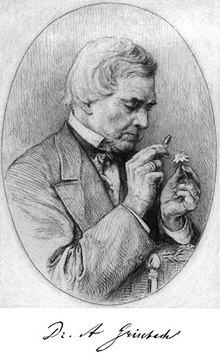August Grisebach
Heinrich August Rudolf Grisebach , also August Heinrich Rudolph Grisebach (born April 17, 1814 in Hanover , † May 9, 1879 in Göttingen ) was a German botanist and university professor . He is considered the founder of plant geography as an independent scientific discipline. Its official botanical author abbreviation is “ Griseb. "
Life
From 1832 Grisebach studied medicine and botany at the University of Göttingen , from 1834 at the University of Berlin , where he was awarded a Dr. med. received his doctorate. From 1837 he was a private lecturer for botany, from 1841 associate professor for general natural history at the University of Göttingen. In 1847 he became a full professor and director of the botanical garden there. From 1844 Grisebach was a member of the Leopoldina .
Between 1839 and 1850 Grisebach undertook several research trips through Europe. In 1838 he published the fundamental work on the influence of the climate on the limitation of natural flora . It contains the sentence that later became famous: "I would like to call a group of plants that have a self-contained physiognomic character, such as a meadow, a forest and the like, a plant-geographical formation" . His classic book Vegetation of the Earth according to its climatic arrangement (1st edition 1872, 2nd edition 1884) provides a first global overview of the vegetation cover with a vegetation map .
Grisebach was a full member of the Göttingen Academy of Sciences since 1851, a foreign member of the Bavarian Academy of Sciences since 1861 and a corresponding member of the Prussian Academy of Sciences in Berlin since April 16, 1874 .
His sons were the architect Hans Grisebach and the writer Eduard Grisebach , his grandson the art historian August Grisebach .
Honors
The genera Grisebachia Klotzsch from the heather family (Ericaceae), Grisebachiella Lorentz from the dog poison family (Apocynaceae), Grisebachianthus R.M.King & H.Rob are named after Grisebach . from the sunflower family (Asteraceae) and Augustea Iamonico from the carnation family (Caryophyllaceae).
Fonts
- Journey through Rumelia and to Brussa in 1839 . Göttingen 1841. (Digital copies from the holdings of the Institute for East and Southeast European Research : Part 1 , Part 2 )
- About the formation of peat in the Emsmooren from their unchanged vegetation. Göttingen 1846 ( digitized in the digital library Mecklenburg-Western Pomerania)
- Spicilegium florae rumelicae et bithynicae exhibens synopsin plantarum quas aest. 1839 legit auctor A. Grisebach , Braunschweig 1843–1844.
- Catalogus plantarum cubensium ... 1866.
- Flora of the British West Indian Islands ... 1859–1864.
- Systematic studies of the vegetation of the caribbean , 1857.
literature
- Helmut Dolezal: Grisebach, Heinrich August Rudolf. In: New German Biography (NDB). Volume 7, Duncker & Humblot, Berlin 1966, ISBN 3-428-00188-5 , p. 96 f. ( Digitized version ).
- Ernst Wunschmann: Grisebach, August . In: Allgemeine Deutsche Biographie (ADB). Volume 49, Duncker & Humblot, Leipzig 1904, pp. 551-554.
Web links
- Author entry and list of the described plant names for August Grisebach at the IPNI
- Malpighiaceae / Grisebach
Individual evidence
- ↑ Holger Krahnke: The members of the Academy of Sciences in Göttingen 1751-2001 (= Treatises of the Academy of Sciences in Göttingen, Philological-Historical Class. Volume 3, Vol. 246 = Treatises of the Academy of Sciences in Göttingen, Mathematical-Physical Class. Episode 3, vol. 50). Vandenhoeck & Ruprecht, Göttingen 2001, ISBN 3-525-82516-1 , p. 97.
- ↑ Lotte Burkhardt: Directory of eponymous plant names . Extended Edition. Botanic Garden and Botanical Museum Berlin, Free University Berlin Berlin 2018. [1]
- ↑ a b c Walter Erhardt among others: The great pikeperch. Encyclopedia of Plant Names . Volume 2, page 1942. Verlag Eugen Ulmer, Stuttgart 2008. ISBN 978-3-8001-5406-7
| personal data | |
|---|---|
| SURNAME | Grisebach, August |
| ALTERNATIVE NAMES | Grisebach, Heinrich August Rudolf |
| BRIEF DESCRIPTION | German botanist and university professor |
| DATE OF BIRTH | April 17, 1814 |
| PLACE OF BIRTH | Hanover |
| DATE OF DEATH | May 9, 1879 |
| Place of death | Goettingen |
